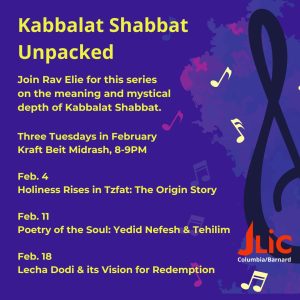 Students at Columbia University and Barnard College recently had the opportunity to dive deep into the mystical dimensions of Kabbalat Shabbat through an enlightening three-part series led by JLIC Director Rav Elie Buechler. The series, initiated by student request, offered a fascinating exploration of the hidden meanings behind one of Judaism’s most beloved prayer services.
Students at Columbia University and Barnard College recently had the opportunity to dive deep into the mystical dimensions of Kabbalat Shabbat through an enlightening three-part series led by JLIC Director Rav Elie Buechler. The series, initiated by student request, offered a fascinating exploration of the hidden meanings behind one of Judaism’s most beloved prayer services.
Each Tuesday evening in February, the Kraft Beit Midrash transformed into a center of spiritual discovery as Rav Elie guided participants through the historical development, poetic structure, and kabbalistic significance of Kabbalat Shabbat. The well-attended sessions created an interactive learning environment where students actively engaged with complex mystical concepts.
A Journey Through Time and Text
The series began on February 4th with “Holiness Rises in Tzfat: The Origin Story,” where Rav Elie traced Kabbalat Shabbat back to its 16th-century roots in the mystical city of Tzfat. Students discovered how the practice evolved from simple field ceremonies to the structured service we know today, learning about influential figures like the Arizal and the Ramak who shaped Jewish mystical practice.
Participants were particularly struck by the revelation that Kabbalat Shabbat functions as a spiritual “wedding ceremony” between the Jewish people and God, with each psalm carefully selected to repair (tikkun) different aspects of the preceding week.
The opening session revealed how Rabbi Chanina would wrap himself in his tallit and proclaim “Let us go out to welcome Shabbat!” – a simple practice that evolved into our modern service.
Poetry of the Soul
The February 11th session, “Poetry of the Soul: Yedid Nefesh & Tehilim,” unpacked the profound love poem “Yedid Nefesh,” written by Tzfat mystic Rav Elazar Azikri. Students examined how this beautiful prayer expresses the soul’s yearning for divine connection, with its acrostic spelling out God’s name of compassion.
Rav Elie highlighted the poem’s four thematic movements—awakening desire, requesting healing, glimpsing divine glory, and seeking redemption—showing how these mirror the spiritual journey of Shabbat itself.
The session explored how “Yedid Nefesh” transcends personal spirituality to express collective Jewish yearning, drawing heavily from Song of Songs imagery to convey spiritual intimacy.
Vision of Redemption
The series concluded on February 18th with “Lecha Dodi & its Vision for Redemption,” exploring Rabbi Shlomo Alkabetz’s masterpiece that has become the centerpiece of Kabbalat Shabbat worldwide. Students were fascinated to learn how the poem’s structure corresponds to kabbalistic concepts of the Sefirot, with careful attention to numerical symbolism and divine unification.
The session revealed how “Lecha Dodi” serves as a cosmic map for redemption, with each stanza building toward the ultimate unification of the divine presence in our world.
Rav Elie unpacked the sophisticated “kabbalistic geography” embedded in the poem, showing how the ten stanzas mirror the ten Sefirot, creating a complete spiritual system within the prayer. Students were intrigued by the precise numerical structure – the opening refrain containing exactly 15 and 11 letters in its two halves, corresponding to different aspects of God’s name that the prayer aims to reunify.
Most powerfully, students grasped how “Lecha Dodi” culminates in a vision of Jerusalem’s restoration and the end of exile, suggesting that our weekly Kabbalat Shabbat practice contributes incrementally to the world’s redemption.
Community Impact
What made this series special was seeing how these ancient mystical concepts still resonate with today’s students.
The interactive format encouraged students to ask questions and share insights, creating a collaborative learning environment that enhanced everyone’s understanding. Participants noted how the series transformed their experience of Friday night services, adding layers of meaning to prayers they had recited for years.
Throughout all three sessions, Rav Elie emphasized how these texts invite us to participate in cosmic repair through our prayers. By understanding the deeper structures and intentions of Kabbalat Shabbat, participants gained not just historical knowledge but practical spiritual tools for enhancing their own Shabbat experience.
The series revealed how this seemingly simple Friday evening service contains within it a complete mystical system—one that continues to offer spiritual nourishment to contemporary Jews seeking deeper connection to tradition and the divine.
Learn More
The complete recordings are available at:
Session 1: Holiness Rises in Tzfat – The Origin Story
Session 2: Poetry of the Soul – Yedid Nefesh & Tehilim
Session 3: Lecha Dodi & its Vision for Redemption
This series exemplifies JLIC’s commitment to providing deep, meaningful Jewish learning experiences that connect Columbia and Barnard students with their rich spiritual heritage. By unpacking the mystical dimensions of familiar rituals, Rav Elie continues to inspire students to find personal meaning in traditional Jewish practice.
Reach out to any of our Directors to learn more about JLIC and to support our programming.
Related Post
Friendsgiving: A Beacon of Community and Gratitude on Campus
A Historic Visit: Chief Rabbi Sir Ephraim Mirvis at Columbia University
A Heartwarming Chessed Initiative: JLIC Students Making a Difference at Harlem Link Charter School